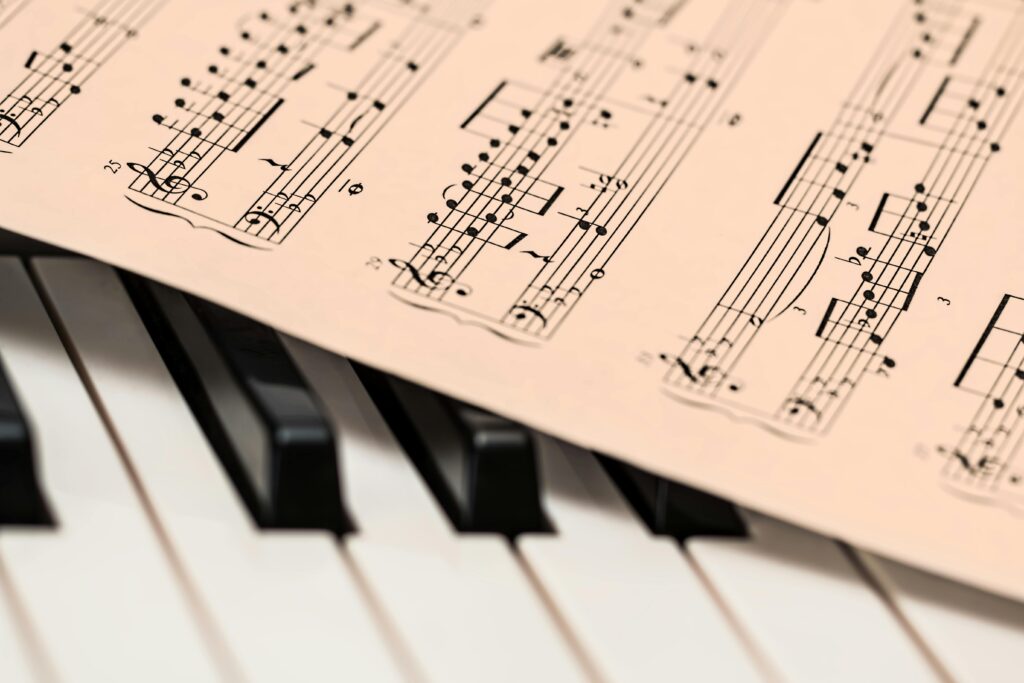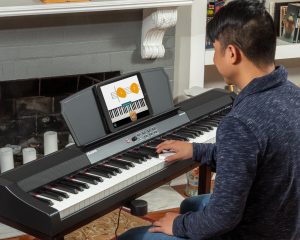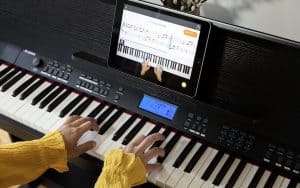Digital trends and developments are continuing to have an outsized effect on music and the lives of musicians. One example of the benefits of this trend is the digitization of sheet music. Digitizing your sheet music helps preserve the longevity of your music collection and provides you with flexible access and use of your aging sheet music.
Having a digital library of sheet music can be a major asset to your practice as a student, teacher, and professional musician. This comprehensive guide will take you through the process of digitizing your piano sheet music, from understanding the basics to utilizing advanced tools and techniques.
- Fall in love with the music - Learn your favorite songs, at a level suitable for you.
- Enjoy interactive piano lessons - Explore courses covering music theory, technique chords & more.
- Get real-time feedback - Skoove's feedback tells you what went well and what needs practice.

Understanding the basics: What does digitizing sheet music mean?
Digitization in the context of sheet music refers to the process of converting physical sheet music into digital formats that can be stored, viewed, and shared electronically. This involves scanning printed music or using software to convert written notes into digital files.
The digitization process ensures that the music is preserved in a format that is immune to physical degradation, such as fading, tearing, or loss.
There are several formats in which digital sheet music can be stored, each serving different purposes.
- PDF (Portable Document Format): The most common format for digitized sheet music, PDFs are easy to view and share. They retain the layout and design of the original sheet music, making them ideal for printing or on-screen reading.
- MusicXML: This is an open, standardized format that represents music notation. It is editable and can be imported into music notation software for further editing or playback.
- MIDI (Musical Instrument Digital Interface): While not a direct representation of sheet music, MIDI files can encode performance information (such as pitch, duration, and dynamics) that can be played back or edited. They are useful for arranging and composing.
The benefits of having digital copies of your sheet music are manifold. Digital copies are easily portable, allowing you to carry a vast library of music on a single device. They are also easily shareable, enabling you to collaborate with others or distribute your music. Moreover, digitized music can be backed up and stored securely, protecting it from physical damage or loss.
Preparing for digitization
Before you begin the digitization process, it’s important to prepare properly to ensure the best results.
Start by choosing the pieces you want to digitize. Prioritize sheet music that is rare, frequently used, or particularly valuable. If you’re digitizing a large collection, consider starting with a few key pieces and expanding your digital library over time.
The quality of your digital sheet music will largely depend on the equipment you use. A flatbed scanner is ideal for producing high-quality scans. For those without access to a scanner, a smartphone or tablet with a good camera can be a viable alternative, especially with the use of scanning apps that enhance image quality and readability.
A clean, well-lit, and organized workspace is crucial for the digitization process. Ensure that your sheet music is free of dust and debris, and that your scanning equipment is properly set up. A stable, flat surface will help prevent any movement or misalignment during scanning, resulting in clearer digital images.
Methods of digitizing piano sheet music
There are several methods to digitize piano sheet music, each with its advantages and potential drawbacks.
Using a flatbed scanner
This method is one of the most reliable ways to digitize sheet music. Place the sheet music on the scanner bed, ensuring it is flat and aligned. Use scanning software to adjust settings such as resolution (typically at least 300 DPI for clear results) and color (black and white or grayscale is often sufficient). Scan each page and save the files in your preferred format, typically PDF for easy viewing and sharing.
Mobile apps for sheet music scanning
For those without a scanner, mobile apps like Adobe Scan, CamScanner, and Sheet Music Scanner can be useful tools. These apps use your device’s camera to capture images of your sheet music and often include features for cropping, adjusting contrast, and converting images into PDFs. While the quality may not match that of a dedicated scanner, these apps provide a convenient and portable option.
Using professional services
If you have a large collection of sheet music or require high-quality digitization, consider using professional scanning services. These services can handle large volumes and provide advanced features like OCR (Optical Character Recognition) to convert scanned images into editable text or music notation.
Organizing your digital sheet music library
Once your sheet music is digitized, organizing it effectively is crucial for easy access and management. Develop a consistent file naming system that makes it easy to identify and locate specific pieces. Include details such as the composer, title, and date in the file name. For example, “Beethoven_Sonata_Op27_No2_2023.pdf” is a clear and informative file name.
Moreover, organize your files into folders based on categories that make sense for your collection. This might include organizing by composer, genre, difficulty level, or type of piece (e.g., sonatas, études, preludes, piano hand exercises). A well-structured folder system will save time and effort when searching for specific pieces.
Backing up your digital library is also important. Protect your digital library by regularly backing up your files. Use cloud storage services like Google Drive, Dropbox, or OneDrive, which provide convenient access and sharing capabilities. Additionally, consider keeping a copy on an external hard drive or other physical media as a safeguard against data loss.
Enhancing and editing scanned sheet music
After digitizing your sheet music, you may need to make enhancements or edits to improve readability and usability. There are various software options available for editing digital sheet music.
- Programs like Adobe Acrobat allow you to edit PDF files, making it easy to adjust brightness, contrast, and other settings. Music notation software like Finale or Sibelius offers more advanced editing capabilities, including the ability to correct notation and layout issues.
- Furthermore, scanned images may contain imperfections such as smudges, skewed lines, or uneven brightness. Use editing software to correct these issues, ensuring that your digital sheet music is clear and easy to read. Adjusting the contrast can help make notes and staves more distinct and the dynamic markings in music more clear, especially in scans of older or worn sheet music.
If you need to make extensive edits or rearrange the music, consider converting your scanned sheet music into an editable format. OCR tools can convert scanned images into MusicXML or other formats that can be edited in music notation software. While OCR technology has limitations and may not always produce perfect results, it can be a useful starting point for further editing.
With your sheet music digitized and organized, you can easily share and use it in various ways. Digital sheet music can be shared with students, colleagues, or fellow musicians via email, cloud services, or dedicated music-sharing platforms. Ensure that you have the necessary permissions to share copyrighted music, and consider watermarking your files if sharing publicly.
Many musicians use tablets or e-readers to display digital sheet music, offering a portable and convenient alternative to physical scores. Apps like ForScore, MobileSheets, and MuseScore provide tools for organizing, annotating, and turning pages, making them invaluable for practice, performance, and remembering piano notes. Digital sheet music can be integrated with various music learning apps to enhance practice and study. For example, Skoove offers interactive piano lessons that can be paired with your digitized music library.
The following video by Akira Ikegami takes us through some easy steps to undertake when you want to transfer your sheet music to an iPad.
Learning and playing piano with Skoove
Skoove is an innovative platform designed to help pianists of all levels learn and improve their skills.
With a library of interactive lessons, Skoove provides a personalized learning experience that adapts to your pace and progress. The platform offers a wide range of pieces, from classical to pop, catering to different tastes and skill levels.
One of the key features of Skoove is its interactive feedback system. As you play, Skoove listens and provides real-time feedback on your performance, helping you correct mistakes and improve your technique and piano hand independence. This feature is especially useful when practicing digitized sheet music, as it allows you to play along with the digital score and receive guidance on your interpretation.
Digitize your library today
Digitizing your piano sheet music is a great way to preserve and enhance your music library. The benefits of digitizing your library include portability, ease of access, and the ability to integrate learning platforms like Skoove.
By following the steps and methods outlined in this article you can help preserve your music library, organize yourself to increase your efficiency in practice, and open yourself to collaboration in unimaginable new ways! Give it a try today and remember to incorporate Skoove along the way!
Author of this blog post:
Susana Pérez Posada

With over seven years of piano education and a deep passion for music therapy, Susana brings a unique blend of expertise to Skoove. A graduate in Music Therapy from SRH Hochschule Heidelberg and an experienced classical pianist from Universidad EAFIT, she infuses her teaching with a holistic approach that transcends traditional piano lessons. Susana’s writings for Skoove combine her rich musical knowledge with engaging storytelling, enriching the learning experience for pianists of all levels. Away from the piano, she loves exploring new places and immersing herself in a good book, believing these diverse experiences enhance her creative teaching style.
Published by Lydia Ogn from the Skoove team














